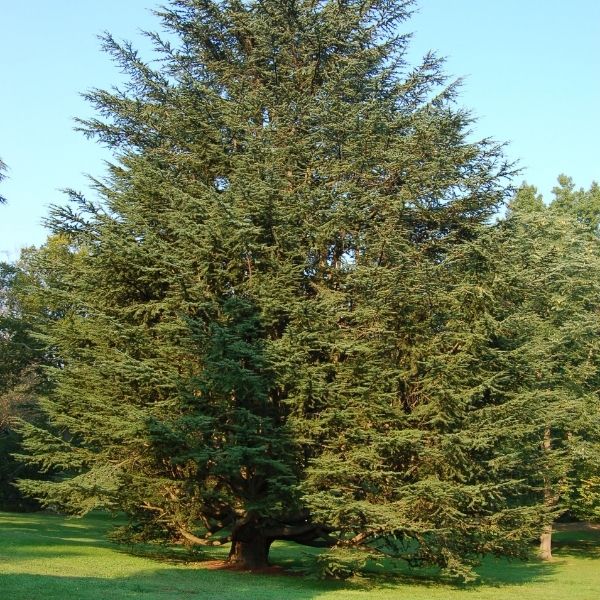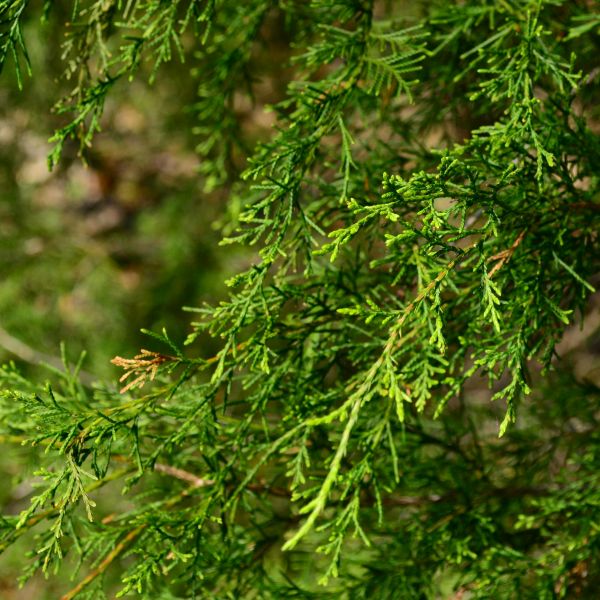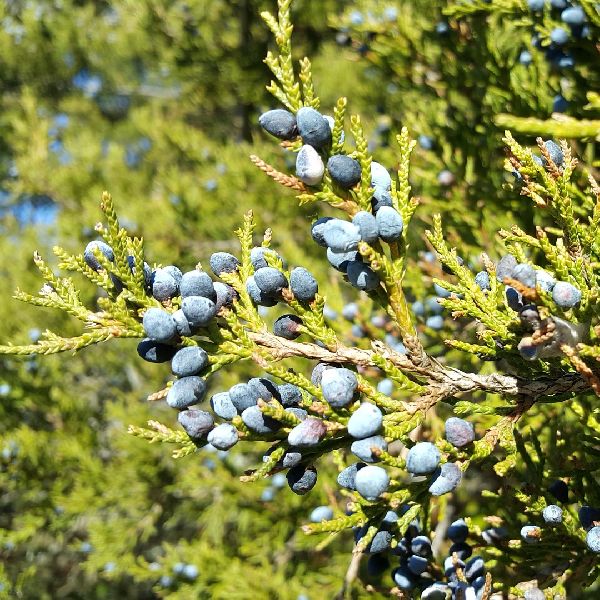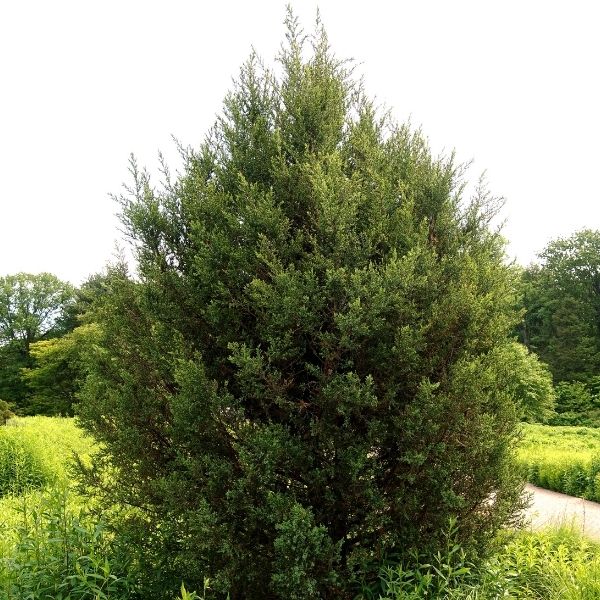Eastern Red Cedar Tree
Juniperus virginiana
- Stay Protected with Plant Sentry ™
Eastern Red Cedar Tree - Quart Container is backordered and will ship as soon as it is back in stock.
Plant Sentry™
Plant Sentry™

Plant Sentry™ Protected
Your order is protected by our compliance system that:
- Prevents restricted plants from shipping to your state
- Ensures plants meet your state's agricultural requirements
- Protects gardens from invasive pests and diseases
Delivery and Shipping
Delivery and Shipping
Delivery and Shipping
Fast, Safe Plant Delivery
Ships in 3-4 business days • Tracking provided • Weather protected
| Under $50 | $9.99 |
| $50 - $99.99 | $14.99 |
| $100 - $149.99 | $16.99 |
| $150 - $198.99 | $24.99 |
| $199+ | FREE |
✓ Zone-specific timing • ✓ Professional packaging • ✓ Health guarantee
Understanding Plant Options
Nature Hills offers plants in two main formats:
- Container Plants: Grown in pots with soil, sized by container volume and plant age
- Bare Root Plants: Dormant plants without soil, sized by height measurements
Container Plant Sizes
Container sizes indicate plant age and growing capacity rather than liquid volume equivalents. Our containers follow industry-standard nursery "trade gallon" specifications, which differ from standard liquid gallon measurements.
Young Plants (6 months to 18 months old)
| Container Size | Actual Volume | Metric Equivalent |
|---|---|---|
| 2" x 2" x 3" | 0.18 - 0.21 dry quarts | 0.20 - 0.23 dry liters |
| 4" Container | 0.31 - 0.87 dry quarts | 0.35 - 0.96 dry liters |
| 4.5" Container | 0.65 dry quarts | 0.72 dry liters |
| 6" Container | 1.4 dry quarts | 1.59 dry liters |
| 1 Quart | 1 dry quart | 1.1 dry liters |
| 5.5" Container | 1.89 dry quarts | 2.08 dry liters |
Established Plants (18 months to 2.5 years old)
| Container Size | Actual Volume | Metric Equivalent |
|---|---|---|
| 2 Quart | 2 dry quarts | 2.2 dry liters |
| #1 Container | 2.26 - 3.73 dry quarts | 2.49 - 4.11 dry liters |
| 5" x 5" x 12" | 3.5 - 4.3 dry quarts | 3.85 - 4.74 dry liters |
Mature Plants (2-4 years old)
| Container Size | Actual Volume | Metric Equivalent |
|---|---|---|
| #2 Container | 1.19 - 1.76 dry gallons | 5.24 - 7.75 dry liters |
| #3 Container | 2.15 - 2.76 dry gallons | 8.14 - 12.16 dry liters |
Large Plants (3-5 years old)
| Container Size | Actual Volume | Metric Equivalent |
|---|---|---|
| #5 Container | 2.92 - 4.62 dry gallons | 12.86 - 20.35 dry liters |
| #6 Container | 5.25 - 6.01 dry gallons | 23.12 - 26.42 dry liters |
| #7 Container | 5.98 - 6.53 dry gallons | 26.34 - 28.76 dry liters |
Bare Root Plants
Bare root plants are sold by height from the root system to the top of the plant. Plants may exceed minimum height requirements.
Common Sizes:
- Trees: 1 foot, 2 feet, 3 feet, 4 feet, 5 feet, 6 feet
- Shrubs & Perennials: 1 foot, 18 inches, 2 feet
Important Notes
Container Volume Specifications
- Trade Gallon Standard: Our containers follow industry-standard "trade gallon" specifications established by the American National Standards Institute (ANSI Z60.1) for nursery stock
- Volume Variations: Actual soil volume may vary due to plant root systems and growing medium settlement
- Age Indicators: Container size primarily indicates plant age and maturity rather than liquid volume equivalents
Growing Conditions
- Plant size can vary based on variety and growing conditions
- Container size helps indicate plant maturity and establishment level
- Larger containers generally mean more established root systems and faster landscape establishment
Seasonal Availability
- Bare root plants are available seasonally when dormant
- Container plants are available throughout the growing season
- Specific varieties may have limited availability in certain sizes
Questions?
For questions about specific plant sizes or availability, please contact our plant experts who can help you choose the right size for your landscape needs.
Plant Highlights
Eastern Red Cedar Tree highlights at a glance!
-
Botanical Name
-
Brand
-
Growing Zones3, 4, 5, 6, 7, 8, 9
-
Growth RateModerate
-
Mature Height
-
Mature Width
-
Leaf Color
-
Fall Color
-
NativeYes
-
Bloom PeriodEarly Spring
Characteristics
Where To Plant
When To Prune
- Late Winter
Water & Moisture Needs
- Low
Sunlight Needs
Soil Needs
- Widely Adaptable
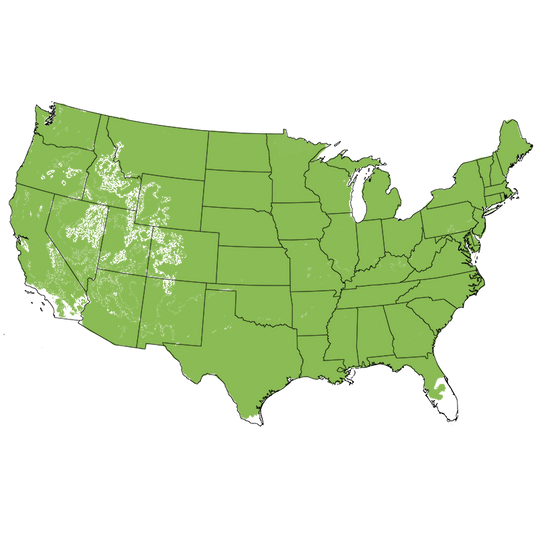
Growing Zones
Birds Love Native Eastern Red Cedar Tree
- Native Evergreen
- Tough, Durable and Drought Resistant
- Wildlife Cover and Bird Magnet
- Wonderful Texture
- Aromatic Wood
- Male and Female Trees
The Eastern Red Cedar (Juniperus virginiana) is one tough old native tree that you can respect. You can find it growing in the wilds of North America - from the eastern seaboard all the way through the country, as far west as Texas and north into South Dakota. You'll see these wild trees flourishing in the harshest of conditions.
Hot and dry sites where road salt and open exposed areas won't even make this plant flinch. Air pollution, shallow and rocky soils, and even soils where Black Walnut grows won't affect the Eastern Red Cedar tree. Deer usually pass on this one, too.
If you're a bird-lover, this is the evergreen tree for you. Eastern Redcedar will attract generations of small mammals, songbirds and game, robins, juncos, warblers, cedar waxwing, sparrows, quail, grouse, pheasants, and wild turkeys. They'll happily work on nesting and roosting in the branches.
The bark is reddish-brown and has a shredding nature that is hidden from view but useful for bird nest construction. Tiny, dark blue, berry-like cones produced by the female tree are a valuable food source for many species of birds.
You'll enjoy a range of colors that start with silvery blue to dark green foliage during the growing season. In the fall and winter, it changes to a purplish color that makes a beautiful accent against your home and outbuildings. Embrace that winter color.
Order now for the best selection!
How to Use Eastern Red Cedar Tree in the Landscape
Plant several along your driveway so you can enjoy the rich, cedar aroma as you arrive home and screen off the neighbor at the same time. Kids of all ages love this rugged, earthy fragrance. The scent will easily connect you to the natural world and ground you in a few moments. What a nice transition for you to shake off your workday.
People also love to clip sprigs for use indoors during the holiday season. They make wonderful wreaths or cut boughs for an invigorating bouquet.
Woodworkers take note. The dark red heartwood is easy to work with, is rot-resistant, and weathers beautifully. It is the wood used to make cedar chests.
Eastern Red Cedar grows with a dense and shaggy texture, but the plants are mostly pyramidal in shape. They look their best if allowed to grow in their natural form. It's a fantastic look for a rustic or contemporary property.
Use these pyramidal Christmas tree-shaped screenings, windbreaks, and shelterbelts, or even a specimen plant for open areas with full sun or partial sun. Try them at the edge of more formal gardens, too, in a sly nod to the transition between manicured and wilderness.
Be sure to include seating nearby, as these trees will deliver incredible bird-watching opportunities.
#ProPlantTips for Care
Red Cedar will grow in almost any dry or moist soil with only one exception... they hate soil that is consistently wet. Once established with a bit of careful attention to water, the plants will become completely self-sufficient and have high drought tolerance.
Hardy and easy to transplant, the Eastern Red Cedar is a low-maintenance tree that will adapt to almost any conditions and provide you with years of enjoyment. While not true Cedars, Eastern Red Cedars are just as aromatic and similar in appearance.
Please note that Nature Hills uses Plant Sentry™ to stop shipments into areas where this tree does a little "too well." It's also best to plant this tree at least 500 feet away from Apple trees to prevent potential Cedar-Apple rust. (Nothing should get in the way of a good Apple crop!)
Order today!
Frequently Asked Questions
Is Eastern Red Cedar a good tree?
Eastern Red Cedars are great fast-growing trees with blue-green evergreen foliage that is a boon to wildlife.
How fast do Eastern Red Cedars grow?
The fast growth rate will add privacy and cover very quickly to your landscape, very quickly achieving at least a couple of feet of new growth each year in optimal conditions.
How tall do Eastern Red Cedars get?
Eastern Red Cedar can achieve a mature height of 40-60 feet in optimal conditions.
Can you keep an Eastern Red Cedar small?
You can use a hand pruner to head back the longer spires of new growth to keep a more natural look to the plant by shortening them as needed. Some like to shear the plants once a year to keep the plants tight and more formal in overall appearance.
What Shipping Options Do You Offer?
NatureHills.com works closely with our growers and nursery professionals to ensure we ship when it is most appropriate for your area. Our goal is to deliver the hardiest plants by avoiding extreme high and low temperatures. Check out our shipping schedule for more information and to learn our wills and won’ts when it comes to shipping plants. Find your Eastern Red Cedar Trees for sale here at NatureHills.com!

